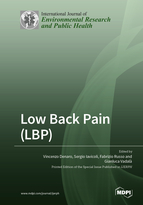Low Back Pain (LBP)
A special issue of International Journal of Environmental Research and Public Health (ISSN 1660-4601). This special issue belongs to the section "Occupational Safety and Health".
Deadline for manuscript submissions: closed (31 December 2021) | Viewed by 80356
Special Issue Editors
Interests: spine; orthopedic and trauma surgery; sports medicine; joint replacement
Special Issues, Collections and Topics in MDPI journals
Interests: occupational health and safety; public health; occupational risks; risk assessment; evaluation of interventions; work-related stress
Special Issues, Collections and Topics in MDPI journals
Interests: spine; spine surgery; musculoskeletal system; orthopedic and trauma surgery; cartilage; osteoarthritis; joint reconstruction and replacement; tissue regeneration; stem cells
Special Issues, Collections and Topics in MDPI journals
Interests: spine biomechanics; intervertebral disc; sport medicine; knee; tissue regeneration; mesenchymal stem cells
Special Issues, Collections and Topics in MDPI journals
Special Issue Information
Dear Colleagues,
We are pleased to announce a new Special Issue on “Low Back Pain”, which we are editing on the International Journal of Environmental Research and Public Health.
Low back pain (LBP) is s a major public health problem, being the most commonly-reported musculoskeletal disorder (MSD) and the leading cause of compromised quality of life, work absenteeism, and chronic disability worldwide. Indeed, LBP is the leading worldwide cause of years lost to disability, and its burden is growing alongside the increasing and aging population. Moreover, LBP is reported by more patients and has a higher impact in the workforce than any other MSD and most other clinical conditions.
Despite the vast amount of research on the management of LBP, the etiology, pathogenesis, and occupational risk factors are still not fully understood. It is crucial to give a stronger focus to reducing the consequences of LBP, as well as preventing its onset. Primary prevention at the occupational level remains important for highly exposed groups. Therefore, it is essential to identify which treatment options and workplace-based intervention strategies are effective in increasing participation at work and encouraging early return-to-work to reduce personal and socioeconomic consequences of LBP. Moreover, the role of workers’ compensation on patient outcomes is not fully explored.
The present Special Issue offers a unique opportunity to update many of the recent advances and perspectives of this health problem. A number of topics will be covered in order to attract high-quality research papers, including but not limited to the following major areas: prevalence and epidemiological data, etiology, prevention, assessment and treatment approaches, and health promotion strategies for LBP. We hope to receive a wide range of submissions, including research on the physical, psychosocial, environmental, and occupational perspectives, also focused on workplace interventions.
We are delighted with the initiative by the International Journal of Environmental Research and Public Health to launch this Special Issue. We invite all experts in the field—clinicians and researchers—around the world to submit their work for consideration in this Special Issue. Manuscript formats can vary from literature reviews (systematic literature reviews and meta-analyses or narrative reviews) to original research (clinical trials, cohort studies, experimental lab work, case-control studies). We particularly welcome multidisciplinary contributions, studies with strong implications for practice, and papers reporting occupational health interventions.
Prof. Dr. Vincenzo Denaro
Prof. Dr. Sergio Iavicoli
Dr. Fabrizio Russo
Dr. Gianluca Vadalà
Guest Editors









